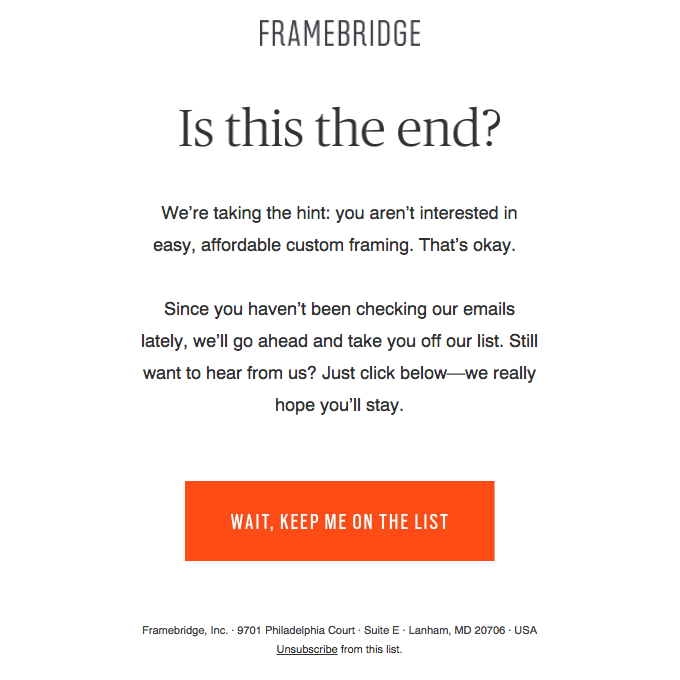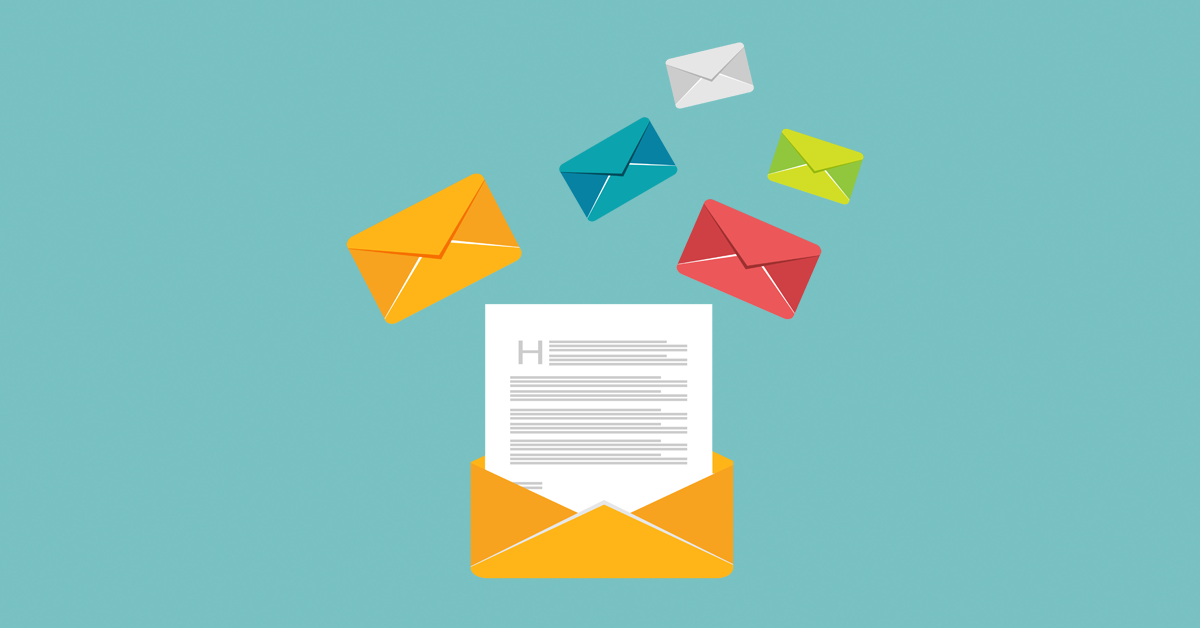Email list cleaning (or email scrubbing, as it’s also known) is the process of identifying and removing inactive subscribers from your mailing list. When cleaning a list, you’ll also be verifying email addresses and removing any that are invalid.
“Wait, did you just say, ‘removing subscribers from your mailing list’? Are you mad?!”
We get it.
It’s a scary prospect for marketers. Especially when one of your key objectives is to grow your mailing list. The last thing you want to do is proactively remove hard-earned subscribers from your list!
But there are really good reasons for doing just that. And while many businesses slow their email marketing pace during lockdown, there’s never been a better time for a little spring clean. So stay with us and discover all you need to know about list cleaning.
Page Contents
Why you should keep your mailing list clean
Email lists decay over time. Not all email addresses on your list remain valid. It could be because a contact signed up with a work email but then changed jobs. Or they simply don’t check that particular account anymore.
Then there’s the issue of inactive, or ‘cold’, subscribers. These are the contacts that signed up to your mailing list but haven’t opened a single email from you.
Neither of these types of contacts make for a healthy mailing list. By regularly purging your mailing list of these invalid and inactive subscribers, you’ll craft a more engaged audience. And you’ll rewarded with better campaign performance, better deliverability and cost savings.
A clean email list increases engagement
When you’re sending your emails to people who want to hear from you, your open and click rates will naturally increase.
Open rate is calculated as a percentage – the number of opens divided by the number of emails sent. If you remove contacts that are not opening your emails, the percentage of subscribers who do open your emails will go up. The same goes for click rate.
Granted, the number of people opening or clicking your emails won’t change. But your metrics will give you a more accurate picture of what’s working with your target audience. You’ll then be able to make better informed decisions when engagement peaks or dips. Which will improve your ability to build more meaningful relationships with your audience.
It’s easy to think of email marketing as a numbers game – the more subscribers on your list, the better.
But you should think of it more as quality over quantity. It’s better to have a smaller but more engaged audience than a larger but less engaged audience. After all, it’s the engaged audience that is going to give you business.
And rather than constantly changing your messages to try and gain more email opens or link clicks from people who aren’t interested, you can focus your efforts on those who are.
A clean email list improves deliverability
If increased engagement wasn’t enough of a reason, how about better deliverability? And getting more of your emails into the inboxes that matter most your business?
There’s a few ways email list cleaning improves deliverability:
1. By lowering bounce rates
There are two types of bounces:
- a soft bounce, which is temporary and indicates that the inbox was not available at the time the email was sent.
- a hard bounce, which is permanent and means that the email address is wrong, the domain no longer exists or the recipient’s email server has blocked delivery.
Invalid and non-existing email addresses will return a hard bounce. And hard bounces damage your sender reputation, which hurts your deliverability.
Internet Service Providers (ISPs) set limits for bounces, as well as spam complaints and unsubscribe requests. The more you email contacts that return a hard bounce, the more likely you are to fall foul of spam filters.
Most ESPs (including EmailOctopus) automatically remove hard bounces from your mailing list. However, you should still play close attention to your bounce rate for an indication of the overall health of your list. The higher the bounce rate, the more ‘dirty’ your list is going to be.
If you keep your mailing list clean of spam and invalid email addresses, you’ll keep your bounce rates low. This is good for your sender reputation and deliverability. And that means more of your emails will reach inboxes.
2. By reducing spam complaints
If subscribers aren’t opening the emails you’re delivering to their inbox, it could be a sign that they’ve marked your email as spam. Which is definitely not good for the overall health of your email marketing.
The more people who mark your email as spam, the higher your chances of finding yourself on an email blacklist. Which means all future campaigns will suffer from poor deliverability.
Email clients like Gmail and Yahoo keep track of which emails are flagged as spam. If enough of your emails are flagged as spam, these mailbox providers will start sending all of your emails straight to the spam folder. So even subscribers that want to hear from you will no longer find your email in their inbox.
The fewer spam complaints, the better your sender reputation. Again, most ESPs will unsubscribe any contact that flags your emails as spam. But it’s still worth keeping an eye on spam complaints as an indicator of list health.
A clean email list reduces your costs
The final reason why you should clean your email list is one that delivers a financial benefit to your business.
The majority of email service providers charge based on the size of your mailing list. So if you can remove a few hundred inactive subscribers, you could save money on your email marketing costs.
After all, why pay to email people who don’t want to hear from you?
Signs your mailing list needs a clean
Whether your mailing list numbers hundreds or many thousands, every email marketer will benefit from a list clean. Though there are a few warning signs that can tell you whether this should be done sooner rather than later.
1. Your engagement rates are falling
If your open rates keep declining, it’s a sign that your subscribers don’t want to hear from you. Or worse, that your emails are going straight to junk.
Keep track of your engagement metrics and look for trends. An unusually low or continually declining open and click rate tells you something is wrong.
2. Your bounce and unsubscribe rates are growing
An increase in the number of unsubscribes and bounces is a sign you’re sending emails to more invalid or uninterested contacts. As a benchmark, a bounce rate of 5% or higher is considered a problem. You want to aim for less than 2%.
And a good unsubscribe rate is anything under 0.5%. If it’s significantly higher than this, it definitely needs some attention as it will be damaging your sender reputation. Which works a bit like a credit score. If you send a lot of bounced or unwanted emails, you’ll get a negative mark on your sender history. And once your reputation drops, it’s difficult to build it up again.
It’s a good idea to check your sender score. And there’s a great free tool to help you do it – SenderScore. Simply enter in your domain and you’ll get an instant report scoring your sender reputation on a scale from 1 to 100. The higher the number, the better your sender reputation.
Five steps to a clean mailing list
Hopefully by now we’ve sold you on why you should clean your mailing list. But now let’s turn our attention to the ‘how’ with a step-by-step guide to a squeaky clean list.
Step 1: Remove duplicate and invalid email addresses
First thing’s first – get rid of all useless email addresses. That includes duplicates and email addresses that don’t actually exist or no longer work.
Your ESP will most likely remove duplicate email addresses for you. Either automatically when you upload a list of contacts or when a subscriber attempts to sign up with an email address that’s already on your list.
However, if you’re moving to a ESP for the first time or want to make sure your list is in tip-top condition before switching ESPs, it’s worth checking for duplicates beforehand.
You can do this using Excel or Google Sheets – both provide the ability to remove duplicate values from a column. In this case, you’ll be removing duplicate email addresses.
It’s also worth checking for typos and correcting those to turn an invalid email address into a valid one. For example, a subscriber might have accidentally entered myname@gmai.com or name@outlok.com.
Again, Excel and Google Sheets can be used to fix this issue, if your email list is small. Simply search for variations of misspellings for popular domains (Gmail, Outlook, Hotmail and Yahoo etc) and fix them directly in the worksheet.
This manual option is far from failsafe but it could save a few subscribers from being lost. It’s also not a great option if you have a large mailing list. For that, you’ll need to use a validation tool, like Bounceless. It’s our preferred way to check a list for invalid, duplicate and spammy email addresses.
It’s also a good idea to look out for generic email addresses like info@company.com or contact@company.com. These types of inboxes are usually blocked by spam filters and emails delivered here are unlikely to be read by real people.
Either remove these types of email addresses from your mailing list or keep them in a separate segment so you can monitor performance more accurately.
Step 2: Identify your inactive subscribers
Next, you need to know who on your list is showing no signs of engagement and could be bringing the overall health of your list down. Compile a list of all subscribers who have not opened an email from you in the past 90 days.
If you’ve only been sending one email a month, extend that to six months to give yourself enough data to make a decision. On the other hand, if you’ve been sending multiple emails each week, you could reduce that timeframe down to the past 60 days.
Remove this list of contacts from your regular campaign list. This effectively means that they’re no longer going to receive the same emails being delivered to your main audience. They are going to receive a dedicated re-engagement campaign instead.
Step 3: Send a re-engagement campaign
Before you remove any contacts off your mailing list, you should give them one last opportunity to engage. Segment your inactive subscribers and target them with a re-engagement campaign (also known as a ‘win-back’).
Ask whether they still want to hear from you and give them an easy way to answer ‘yes’ or ‘no’. A ‘no’ should be a direct unsubscribe so you don’t have to do anything further.

If they reply ‘yes’, set up a drip campaign to nurture them to take a desired action, whether that’s making a purchase on your website or downloading content in your emails.
If you’ve got a CRM, you could also give subscribers the choice of how often they hear from you. Perhaps the weekly newsletter you send out is too frequent for them but once a month would be ideal. The more control you can give your contacts over how and when they hear from you, the more receptive to your messages they are likely to be.
Step 4: Remove the “last chance” inactive subscribers from your list
After your re-engagement campaign, you’re likely to have a small percentage of subscribers who have interacted with your emails and expressed an interest in hearing from you again in the future.
Unfortunately, the majority of the contacts who received your re-engagement campaign will still not have opened or clicked your email. But that tells you something valuable – these contacts are definitely not interested in your emails. They are so unengaged that they couldn’t even be bothered to unsubscribe!
You gave it your best shot but they’re just not biting. Now you have to make the hard and unintuitive decision to unsubscribe them yourself. And focus your attention on the engaged and active mailing list you’re left with.
But don’t delete that list of unengaged contacts completely. Keep this list somewhere safe so you can use these contacts for retargeting ad campaigns on other channels, like Google Display and Facebook. Email might not have worked but there could be another channel out there that brings them back to your brand.
Step 5: Manually remove canned-response email subscribers
If you’ve got a list numbering thousands, skip this step entirely. It’s time intensive and laborious.
But if you’re working with a smaller list, it’s worth your time. Simply search your reply-to inbox (where replies to your emails are received) for automated replies. This could be an out-of-office response that tells you the person you’re trying to reach no longer works for that company. Or it could be an undeliverability notification. Look out for “AutoReply” in the from-field or “Thanks for your message” in the subject line.
Once you’ve found them, manually unsubscribe those contacts from your mailing list.
How often you should clean your list
This ultimately depends on the size of your mailing list. If it’s in the hundreds of thousands, it’s a good idea to scrub your list on a regular basis. That could mean every couple of weeks.
However, for most email marketers, once every three months is a good timeframe. This gives you enough time to collect data on who’s opening your emails and allows time for new subscribers to show how engaged they are too.
As your mailing list grows, you might want to increase this frequency. And if you’ve never cleaned your list, now’s a great time to do it!
You should also clean your contacts whenever you upload a new list to your email marketing platform. Or when you switch between providers.
Another good time to clean your list is after running a large sign-up campaign. For instance, if you’re using a competition or giveaway to grow your mailing list, you’ll want to give those new sign-ups a clean before you send your next campaign. The quality of these sign-ups can often be poor – they’re probably more interested in the prize and not your brand. So it’s important to validate this new list before risking your sender reputation.
Tips on how to maintain good email hygiene
Periodic list scrubbing is one way to keep your list nice and clean. But it’s important to maintain these following practices to ensure ongoing deliverability improvements. And better email marketing performance.
Use double opt-in sign-ups
This requires a higher level of engagement from new subscribers and also helps validate email addresses from the get go. It avoids having misspelled email addresses added to your mailing list and increasing your bounce rates too.
Make it easy to unsubscribe
It’s a legal requirement of GDPR and other international email marketing regulations to always provide contacts with the option to unsubscribe.
Resist the temptation to bury your unsubscribe button so that fewer people unsubscribe. An unsubscribe is better than a spam complaint so give contacts a clear and easy way to remove themselves from your mailing list.
Set up a preference centre
Use your CRM to set up a preference centre and provide subscribers with the option to hear from you on a less frequent basis. That way you can keep them on your list and send them regular round-ups of content that they’re interested in.
If you can’t set up a preference centre, survey your contacts instead. Ask questions to find out how they prefer to hear from you and what types of messages they want to receive.
Consider a more detailed sign-up form
In most circumstances, you’ll want to keep your mailing list sign-up form minimal. Name and email address is the basic information you’ll ask for.
But if the quality of your contacts is poor, adding more fields to your sign-up form could help. It will weed out those who aren’t seriously interested in your product or service. And will better qualify those that are.
Segment your audience
By segmenting your audience, you reduce the number of emails being sent and make each email more relevant to your contacts.
You can also create different campaigns to target warm and cold subscribers using segmentation. Every three months, send a re-engagement campaign to anyone who hasn’t opened an email from you in the past 90 days.
Include a sentiment widget in your emails
Engagement metrics like open rates and click rates will give you a pretty good indication of how subscribers feel about your emails. But if you want more explicit feedback, add a sentiment widget to your emails.
This invites recipients to rate your email. And if you link through to a (very) brief survey page, you’ll gain invaluable insight into why your emails aren’t resonating with your audience.
Manage soft bounces
After each email campaign, check your campaign reports and look at the contacts who returned a soft bounce. If they’ve delivered a soft bounce for the last five sends, unsubscribe them from your list.
Tools to help keep your mailing list clean
We’ve mentioned a few useful tools throughout this article and here they are rounded up in a helpful little list:
- Bounceless – a simple email verification service that checks your list for spam traps, invalid email addresses and duplicates. You can pay as-and-when you need it with prices depending on the number of contacts in your list.
- Pabbly – this is another email verification service, but while others deliver results within a matter of hours, Pabbly purposefully takes a few days to more accurately provide results. So while it might not be the best option if you need a quick turnaround, it’s a good choice for prepping mailing lists before an ESP switch or big campaign.
- Sender Score – this nifty free tool evaluates your email reputation and provides you with insights into how ISPs view your emails. Consider it a health checkup so you know how much work needs to be done on improving your deliverability.
- Email Sentiment Widget Builder – add this to your emails to invite recipients to rate your emails. You’ll need to set up landing pages for each sentiment (positive or negative). And ideally collect further feedback via a one-question survey.





No Comments
Leave a comment Cancel